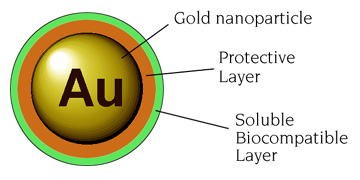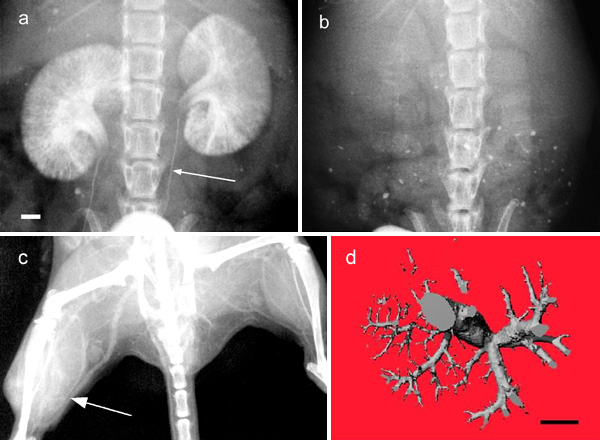Strike Imaging Gold
Gold nanoparticles:
a better x-ray contrast agent
for critical applications
-a breakthrough for angiography,
kidney imaging and CT scans |
|
Related products now available for research applications:
Unparalleled x-ray contrast agent for micro-CT!
|
|
|
Opportunity
Nanoprobes has developed the first X-ray contrast agents for critical angiography and kidney maging applications that use gold nanoparticles. These agents have important advanages over conventional iodine or gadolinium-based contrast agents. They provide enhanced imaging in patients for whom iodine achieves insufficient contrast. They are also excellent for kidney imaging, both because their residence profile allows concentration in the kidneys before clearance, and especially since they do not exhibit the nephrotoxicity properties associated with iodine or gadolinium contrast agents.
| Market segment |
Advantages |
| Obese patients |
Contrast up to 10 x that of iodine-based reagents.
Longer residence time = longer imaging time.
|
| Patients with renal damage |
Very low osmolality and viscosity reduce risk of further damage.
|
| Iodine-allergic patients |
Non-allergenic.
|
Technology
 |
- Stable, biocompatible gold nanoparticles.
- Bioconjugation of gold nanoparticles.
- Patented: contrast media and methods.
|
Gold is a Better X-Ray Contrast Agent
 |
Micro-CT planar X-ray (upper images): Kidneys in live mouse 60 minutes after intravenous injection of
(a) gold nanoparticles or (b) iodine contrast medium (Omnipaque H). Arrow: 100 nm ureter (Bar = 51 mm) (High-resolution image).
(c) Cancer imaging: X-ray of mouse hind legs showing accumulation of gold and significant contrast (white, arrow) in tumor growing on leg on left, compared with normal contra-lateral leg. Much of gold is in vasculature, illustrating angiogenic effect of tumor. Longer residence time in blood results in a significantly higher tumor : non-tumor ratio than is possible with iodine reagents (Bar = 51 mm) (High-resolution image).
(d) Micro-CT showing resolution available with gold nanoparticle contrast agents: 3 nm section of mouse abdomen after gold nanoparticle injection, showing branching of inferior vena cava and 25 µm blood vessels (bar = 1 mm) (Bar = 51 mm) (High-resolution image).
|
Advantages of Gold as an X-ray Contrast Agent
- Gold absorbs more than iodine (3 x at 100 keV), enabling higher contrast at lower X-ray dose and higher resolution.
- Gold nanoparticles stay in the blood longer. Repeated administration gives a higher concentration at a lower total dose than iodine.
- Gold can be concentrated to 1.5 g Au/mL, 5 x higher than iodine agents. With 3 x higher absorption, this enables 15x higher opacity.
- Gold nanoparticles are non-toxic. Iodine agents can produce adverse reactions including anaphylactic shock and kidney failure.
- Very low osmolality helps avoid side-effects.
- Low viscosity, even at very high concentration, unlike viscous iodine agents.
- Golds K-edge at 80.7 keV enables imaging away from bone and soft tissue absorption. Bone interferes with iodine (K-edge 33 keV).
- Gold nanoparticles enable targeted molecular imaging of tumor, atherosclerotic, inflammatory, stroke, and other markers.
The simulation below shows a direct comparison of gold at maximum concentration with iodine-based contrast agents at maximum concentration, using capillaries of different internal diameters to simulate different sized blood vessels, and layers of polystyrene to simulate tissue thicknesses typical of a large or obese patient.
![[Phantom comparison: gold vs. iodine in capillaries of different thickness (38k)]](../Images/ImgGold_Fig3.jpg) |
|
Imaging of gold vs. iodine reagents in simulated blood vessels. Polystyrene was used to emulate tissue thickness typical of a large or obese patient (High-resolution image).
|
Applications for our gold x-ray contrast agents
- Cancer imaging: longer residence time in blood gives higher tumor : non-tumor ratio than is possible with iodine reagents.
- Targeted contrast agents to image targets with molecular selectivity.
- Cancer therapy. High-Z materials absorb X-rays more strongly than tissue, enhancing the radiation dose. Gold nanoparticles are highly effective due to their high absorption cross-section.
Nanoprobes now offers a research formulation of this contrast agent, AuroVist™, as a reagent for microCT imaging and in vivo vascular casting of small animals for research applications.
We're looking for a partner!
We developed this reagent for use in critical human applications: angiography in severely compromised patients, and kidney imaging without the toxicity hazards of iodine or gadolinium reagents. We are seeking a partner who can bring this successfully to market.
Our ideal partner:
- Seeking gain in X-ray contrast agent market share through new technology.
- Regulatory expertise and experience.
- Manufacturing and distribution infrastructure.
- Marketing: understands and promotes product advantages and capabilities.
- Specialized sales force to promote and educate physicians.
About Nanoprobes:
- Mission: use gold nanoparticle technology to solve medical problems.
- Unique expertise in using gold nanoparticles for biomedical applications.
- 15 years of sales growth, internal technology and IP development.
- $10 million SBIR and STTR research support from multiple NIH (multiple institutes), National Science Foundation and US Department of Energy.
Contacts:
Technology development supported by Small Business Innovation Research (SBIR) grant HL076046 from the National Heart, Lung and Blood Institute (National Institutes of Health).
|
|
|



![[Phantom comparison: gold vs. iodine in capillaries of different thickness (38k)]](../Images/ImgGold_Fig3.jpg)